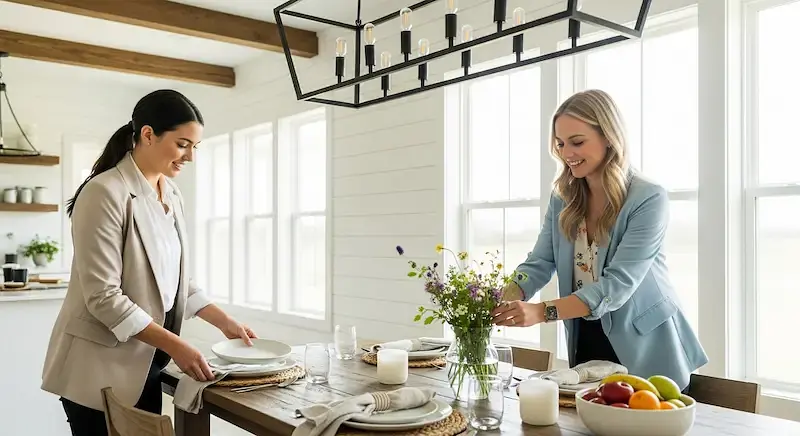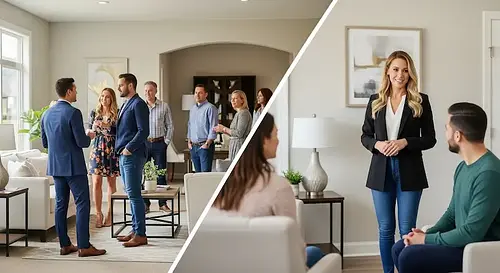How To Stage A Dining Table For An Open House
Learn how to stage a dining table for an open house with simple, proven tips. Discover table-setting ideas, centerpiece styles, and staging strategies that help buyers envision themselves in the home.

Written by Seth Cox
Aug 21, 2025 / Open house marketing
In this guide, you’ll learn exactly how to stage a dining table for an open house. We’ll cover simple table-setting tips, centerpiece ideas, and styling strategies that make a lasting impression without overcomplicating the process.
Related: How to stage your home for an open house
An Inviting Dining Table Sets The Stage
Dining areas also set the tone for the rest of the home. A clean, thoughtfully staged table makes the entire space feel more put together and welcoming. On the flip side, a cluttered or bare table can make the home feel unfinished or neglected.
Your job isn’t to create something over the top. It’s to create a moment buyers can see themselves stepping into, and a staged dining table does exactly that.

How to Stage a Dining Table for an Open House
Here are a few best practices to guide your staging:
- Keep it clean and balanced — Start with a spotless table and avoid cluttering it with too many items.
- Stick to neutral tones — Soft, neutral colors appeal to a wider range of buyers and keep the focus on the home, not the décor.
- Choose a focal point — A simple centerpiece draws attention and adds warmth without overwhelming the space.
- Match the vibe of the home — If the property has a modern feel, go with sleek and minimal settings. For a more traditional home, layer textures and use warmer accents.
- Avoid perfection — A perfectly staged table can look fake. A few casual touches, like slightly angled napkins or one empty chair, can make the space feel more natural.
Related: How and why to invite neighbors to your open house
5 Step Guide to Staging a Dining Table
-
Clear and Clean the Space
Start with a blank canvas. Remove any clutter from the table and surrounding area, including extra chairs, paperwork, and personal items. Wipe down the table, chairs, and light fixtures so everything looks fresh and polished. A spotless surface always sets the stage for better styling.
-
Choose the Right Table Setting Style
Decide what style works best for the home and the target buyer. A formal setting with layered dishes and elegant glassware can work for high-end properties, while a casual setup feels better in family-friendly homes. Consistency is key. Match your staging style to the property’s vibe so everything feels intentional.
-
Use Simple, Neutral Tableware
Neutral colors are your best friend here. Stick to clean, modern plates and clear glassware that appeal to most buyers. Avoid bold patterns, mismatched dishes, or bright colors that distract from the room itself. The tableware should complement the space, not compete with it.
-
Add a Centerpiece That Pops
Choose one standout item to anchor the table. Fresh flowers, a low vase of greenery, candles, or a decorative bowl work perfectly. Keep it proportional to the table size and avoid anything too tall that blocks sightlines. A simple centerpiece instantly makes the table feel inviting without overwhelming the space.
-
Layer with Textures and Accents
Once the basics are set, add depth with subtle layers. A neutral runner, woven placemats, or elegant chargers can create dimension and visual interest. If you want a little color, bring it in through napkins or small accents rather than overwhelming the entire setup. Less is more here.
Tips for Staging a Dining Table in Different Scenarios
.webp)
Open Concept Floor Plans
- Use an area rug under the table to create a visual boundary between dining and living zones.
- Choose a pendant or chandelier that anchors the space without blocking sightlines.
- Keep centerpieces low and simple so buyers can see across the room.
- Position the table to create a natural path between the kitchen and living area.

Small Dining Areas
- Choose a table that fits the space, even if it’s smaller than average. Oversized furniture can make the area feel tight.
- Use lighter tones for tableware, linens, and décor to create the illusion of more space.
- Limit place settings to two or four seats to make the layout feel less crowded.
- Opt for a single, simple centerpiece instead of multiple decorative pieces.

Luxury Properties
- Use high-quality linens, polished flatware, and layered place settings to create a sense of refinement.
- Add texture through runners, chargers, and napkin rings for a designer-inspired look.
- Incorporate fresh flowers, sculptural vases, or seasonal greenery for a polished finish.
- Use symmetry to create balance but keep a few elements slightly varied for a natural, lived-in feel.
Should You Set the Table When Staging a Home?
Why Setting the Table Works
- Use three to four place settings instead of filling every seat to keep the look light and approachable.
- Stick to neutral, high-quality plates and glassware that appeal to a wide range of buyers.
- Add subtle layering with chargers, folded napkins, or linen runners for depth and polish.
- Keep centerpieces low and proportional so the table feels open and functional.
When to Skip the Table Settings
Alternatives to full settings:
- Use a single decorative bowl, fresh flowers, or greenery as a soft focal point.
- Style the chairs neatly to create symmetry and a sense of space.
- Keep the tabletop free of clutter to highlight size and surface quality.
Finding the Right Balance

Dining Table Staging vs. Kitchen Table Staging
Staging the Dining Table
- Use layered place settings to suggest special dinners and family events.
- Choose one striking centerpiece to anchor the table and add personality.
- Complement the style of the dining room — traditional, modern, rustic, or transitional.
- Leave enough space around the table for buyers to walk comfortably and visualize flow.
Staging the Kitchen Table or Breakfast Nook
- Keep styling minimal, using fewer props than the dining area.
- Use simple place settings for two or three seats instead of setting the entire table.
- Add a small vase of fresh flowers, greenery, or a decorative bowl for a pop of color.
- Avoid overly formal décor that feels out of place in a kitchen environment.
How to Keep the Two Spaces Cohesive

Common Dining Table Staging Mistakes to Avoid
Overcrowding the Table
- Limit place settings to two, four, or six depending on table size.
- Choose one centerpiece instead of multiple competing elements.
- Leave open surface space so the table feels functional and livable.
Using Distracting or Outdated Décor
- Stick to neutral, modern plates and glassware.
- Avoid loud patterns or unusual colors that won’t appeal to a broad audience.
- Choose timeless decorative accents over trendy seasonal fads.
Ignoring Scale and Proportion
- Match the size of the centerpiece to the size of the table.
- Use low-profile items on smaller tables to avoid blocking sightlines.
- Balance tableware and décor so nothing feels too heavy on one side.
Making the Setup Look Too Perfect
- Angle napkins slightly instead of folding everything perfectly.
- Leave one or two chairs unstyled to make the setup feel natural.
- Avoid over-layering tableware or adding props buyers wouldn’t use daily.
Forgetting to Tie It All Together
- Keep a consistent color palette throughout nearby spaces.
- Use similar finishes, textures, and materials to connect the rooms.
- Choose staging elements that complement the rest of the home’s style.
Final Thoughts
And while staging helps buyers fall in love with a home, managing the open house itself is just as important. That’s where Showable comes in. From scheduling and sign-ins to follow-ups and reporting, Showable gives you the tools you need to host smoother, more successful open houses — and generate more leads in the process.






